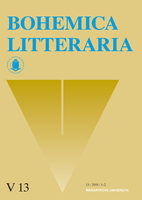Pokus o vymezení imanentní sémantiky jezera
An Attempt at Outling the Immanent Semantics of the Lake
Author(s): Žoržeta ČolakovaSubject(s): Semiology, Semantics, Philosophy of Religion, Biblical studies, Hermeneutics, Theory of Literature, Ontology
Published by: Masarykova univerzita nakladatelství
Keywords: Genesis of the image of the lake; the antique conception of water; Biblical variations of the image of the lake; the idyllic and the apocalyptical perception of the lake;
Summary/Abstract: The article analyzes the presence of the lake in the Antiquity and in the Bible, as well as the literary tradition related to them until the end of the 18th century. The study of the semantic ontology of the image shows that at this time it still does not have its own range of imagery. It will be outlined and actively interpreted for the first time by Romanticism. The ancient concept of the world as being of constantly changing shapes prefers the variations in the image of flowing water (river, stream) and endless water space (ocean, sea) that reflects the world’s cosmogony. Lake has rather narrow but nevertheless clearly outlined semantic field that refers to chthonic or transitive space. Exactly as an entrance to the world of the dead it is toponomically identified in the name of Lake Avernus. We find identical meaning of the lake also in the Bible text. The background of the references in the Old and the New Testament highlights its infernal projection in the Revelation as “the lake which burneth with fire and brimstone”. This is the only case where different Bible translations do not substitute the image with another hypostasis of water. Observations also show that while the outside empirical world is axiologized in various ways, the biblical mind, just like the ancient one, perceives the lake as a transcendent topos. Representative examples from literary works and art illustrate that the artistic mind strictly follows the eschatological interpretation of the lake and as a result the image is either missing or has quite marginal presence as a part of the landscape. The special attention Romanticism pays to the image of the lake has to be explained not merely with its interest in commensuration of human intersubjectivity with the whole universe, but first and foremost with the metaphysical approach of romantic authors to the mysterious and impenetrable depths of being.
Journal: Bohemica litteraria
- Issue Year: 13/2010
- Issue No: 1-2
- Page Range: 47-59
- Page Count: 13
- Language: Czech

